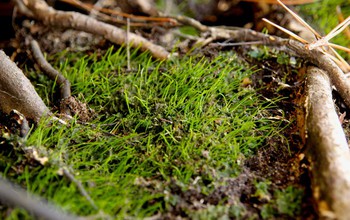All Images
News Release 18-098
NSF announces new awards for research to better understand Earth’s biodiversity
Projects simultaneously explore ecological and evolutionary processes to grasp synergistic impact
This material is available primarily for archival purposes. Telephone numbers or other contact information may be out of date; please see current contact information at media contacts.

An aquatic ecologist at the University of Alabama Tuscaloosa, Carla Atkinson studies mussels from the diverse community of the Duck River in Tennessee. Atkinson studies the evolutionary ecology of freshwater mussels. From top to bottom, left to right: Rabbitsfoot (Theliderma cylindrica), Round hickorynut (Obovaria subrotunda), Wavyrayed Lampmussel (Lampsilis fasciola), Cumberland Monkeyface (Theliderma intermedia), Birdwing Pearlymussel (Lemiox rimosus), Duck River Dartersnapper (Epioblasma ahlstedti), Spike (Elliptio dilatata).
Credit: Carla Atkinson, University of Alabama
Download the high-resolution JPG version of the image. (3.2 MB)
Use your mouse to right-click (Mac users may need to Ctrl-click) the link above and choose the option that will save the file or target to your computer.

In July 2008, Karl Hambright from the University of Oklahoma was part of a team that took samples from this cyanobacterial algal bloom in Lago de Patzcuaro, Mexico. Hambright will lead a team of researchers with his Dimensions of Biodiversity project to better understand patterns in functional biodiversity in these types of algal blooms.
Credit: Alan Wilson, Auburn University, School of Fisheries, Aquaculture, and Aquatic Sciences
Download the high-resolution JPG version of the image. (281.3 KB)
Use your mouse to right-click (Mac users may need to Ctrl-click) the link above and choose the option that will save the file or target to your computer.

Every hornwort species is capable of a symbiotic relationship with cyanobacteria, making it a good plant to study to understand plant interactions with nitrogen-fixing microbes. Fay-Wei Li at the Boyce Thompson Institute of Plant Research will study the diversity of this hornwort-cyanobacterium symbiosis.
Credit: Fay-Wei Li
Download the high-resolution JPG version of the image. (4.4 MB)
Use your mouse to right-click (Mac users may need to Ctrl-click) the link above and choose the option that will save the file or target to your computer.

Chris Marx, an evolutionary biologist from the University of Idaho, will look specifically at methylobacterium, which are a bacteria found in soil, in sewage and on the surfaces of leaves. His work will help better understand the evolution of a diverse bacterial community.
Credit: University of Idaho Photographic Services
Download the high-resolution JPG version of the image. (511.7 KB)
Use your mouse to right-click (Mac users may need to Ctrl-click) the link above and choose the option that will save the file or target to your computer.

Marjorie Weber, a plant biologist at Michigan State University, studies the evolution of mutualistic plant defenses, mechanisms where plants and their "pests" can co-exist in beneficial fashion to both species. Here she shows where tar was experimentally applied to block the mite domatia on wild grape leaves to study ecological consequences. Domatia are structures that the plants have produced specifically for the mites to use.
Credit: Harley J. Seeley
Download the high-resolution JPG version of the image. (314.3 KB)
Use your mouse to right-click (Mac users may need to Ctrl-click) the link above and choose the option that will save the file or target to your computer.
